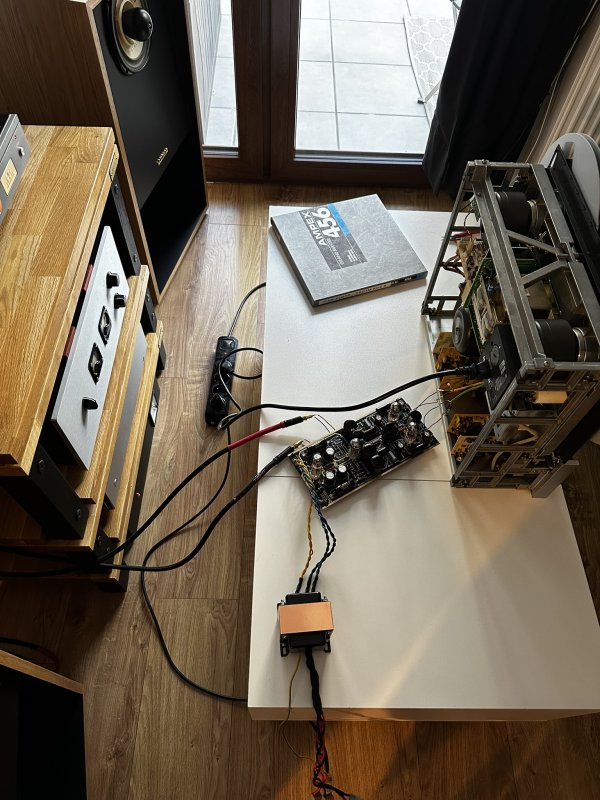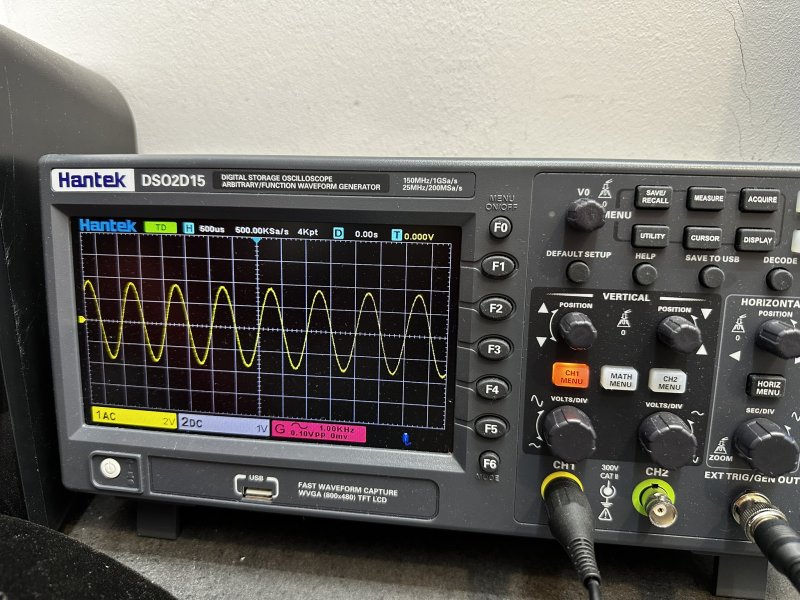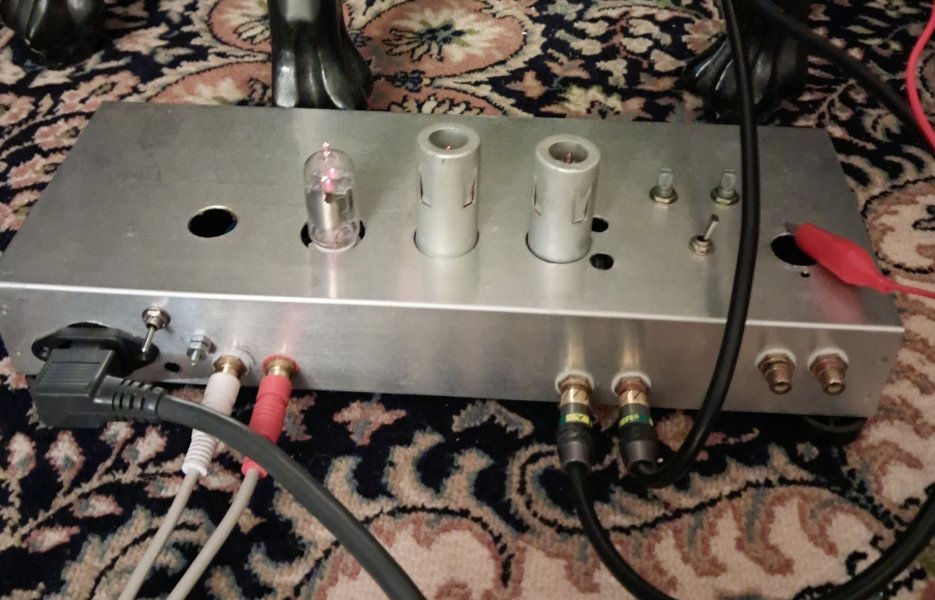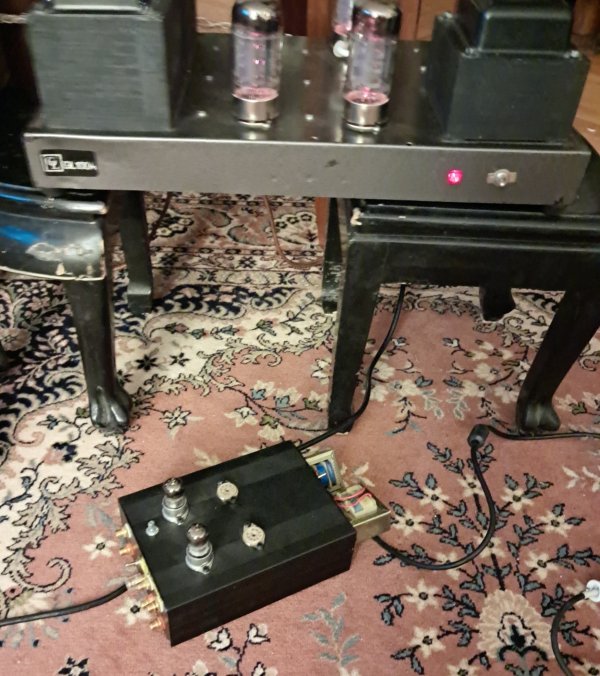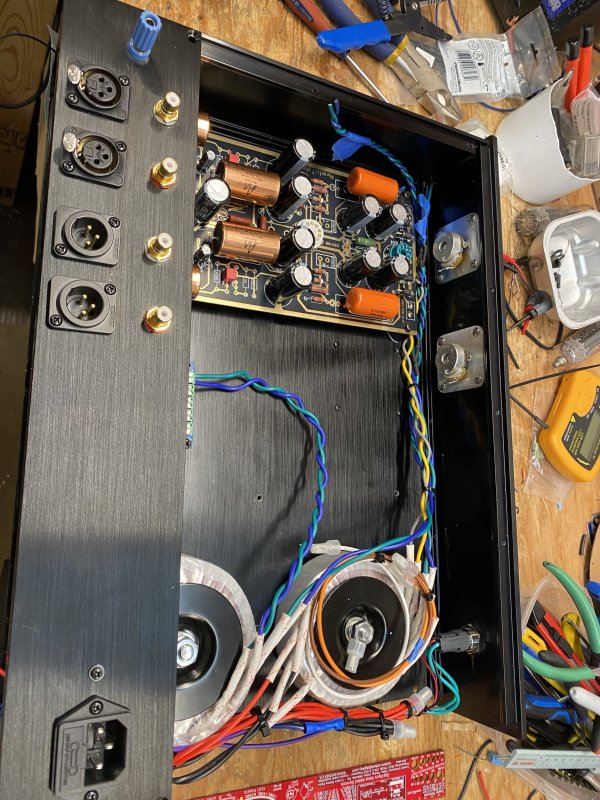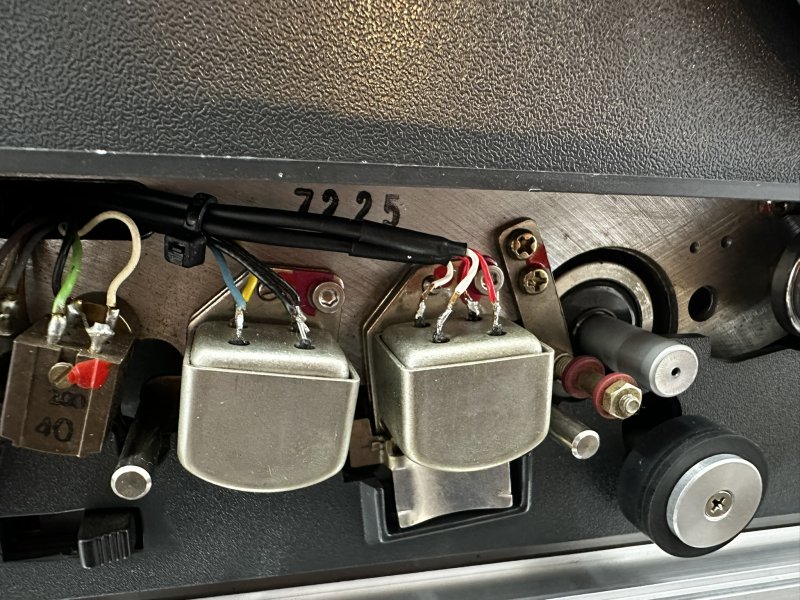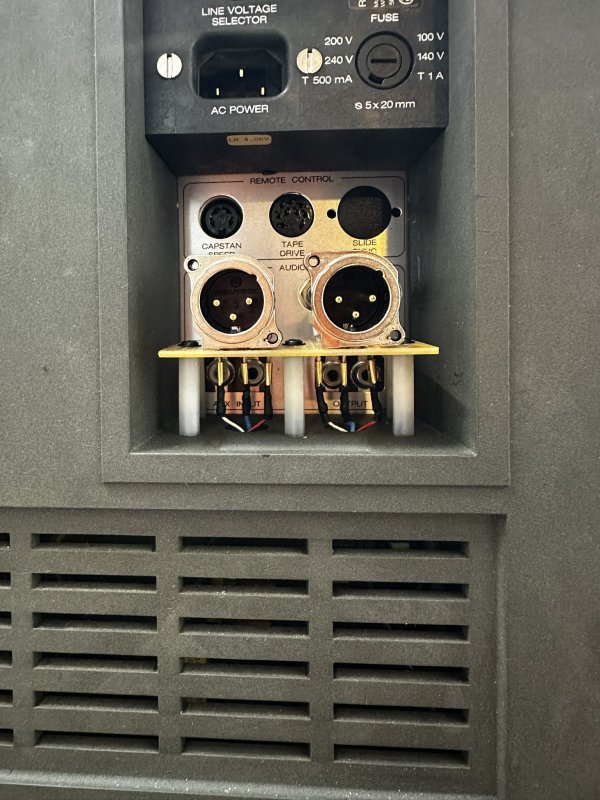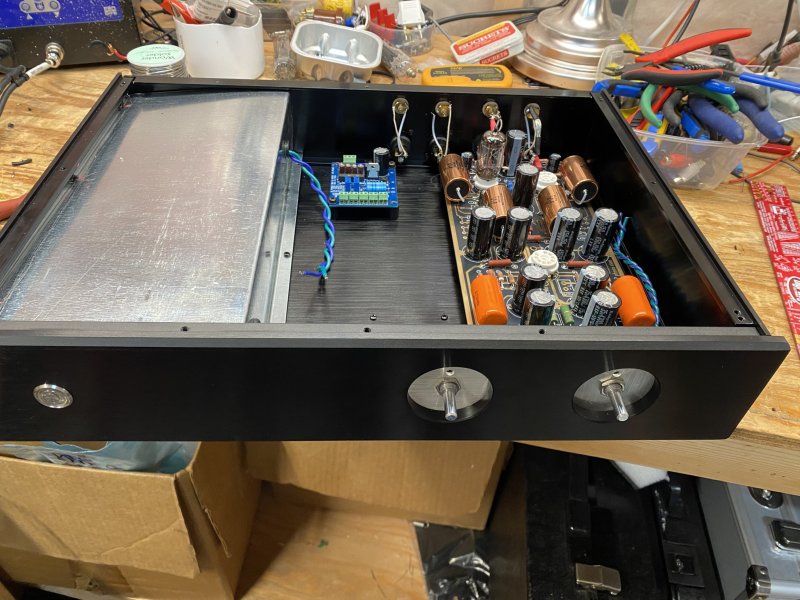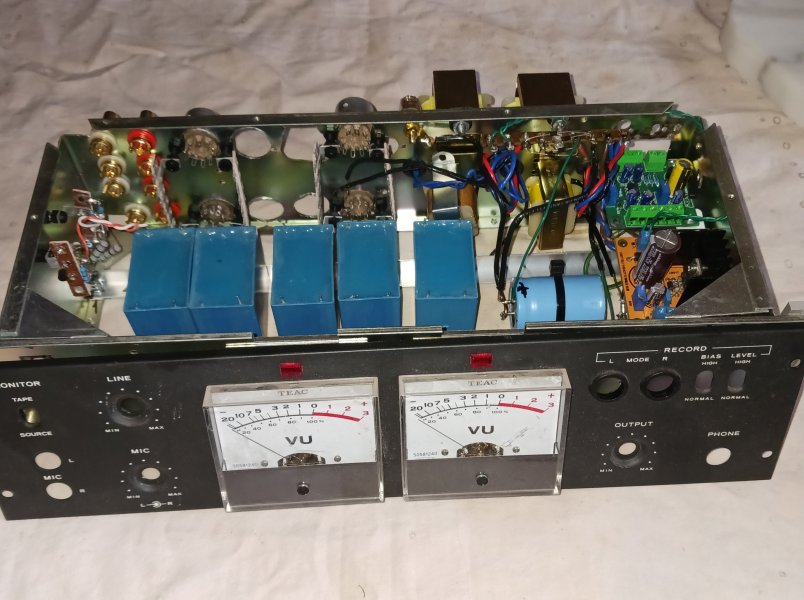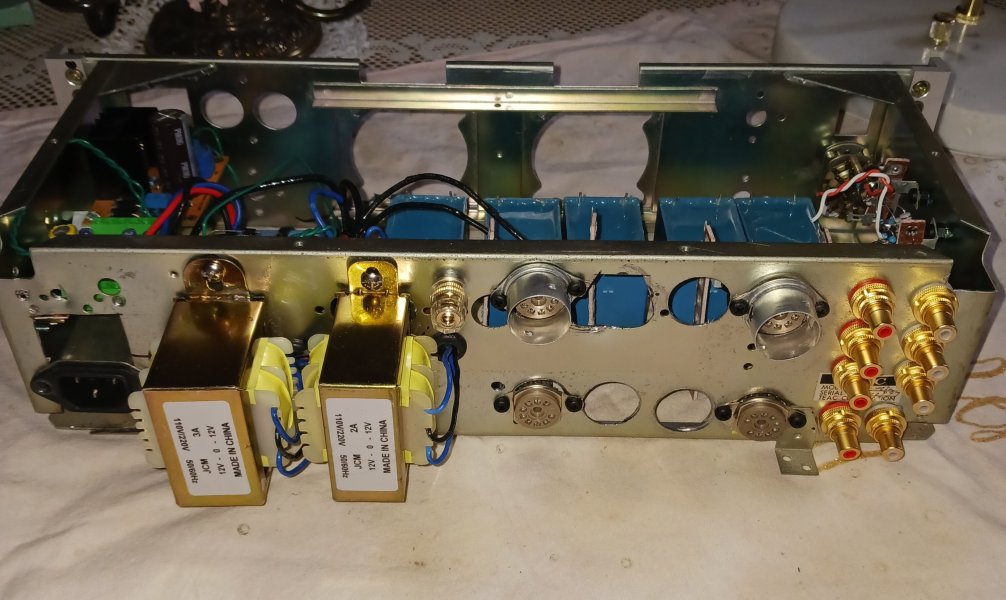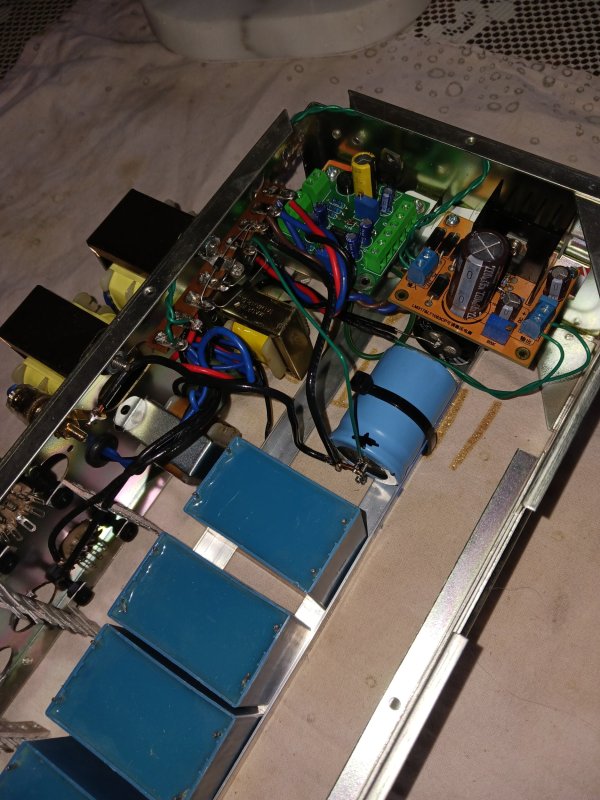Marantz 7 clone tape head preamp
- Thread starter adrianywu
- Start date
You are using an out of date browser. It may not display this or other websites correctly.
You should upgrade or use an alternative browser.
You should upgrade or use an alternative browser.
Quick update:
The preamp is working, it works flawlessly. The sound is also very pleasant, but so far I don't have any screening and I connected it with thin cables, so there was some interference from the capstan motor.
Below you can see photos from the construction and an oscilloscope graph. When I fed a 1kHz; 0.1V signal into the input, I got about 3.4V at the output.
The capacitors are Mundorf ZN, the tubes are Tung-Sol, and I bought the transformer on Aliexpress together with the PCB.
I will post a few more photos later when the enclosure is ready. I also plan to add VU meters.
Thank you again for your advice on this project, I had a lot of fun
The preamp is working, it works flawlessly. The sound is also very pleasant, but so far I don't have any screening and I connected it with thin cables, so there was some interference from the capstan motor.
Below you can see photos from the construction and an oscilloscope graph. When I fed a 1kHz; 0.1V signal into the input, I got about 3.4V at the output.
The capacitors are Mundorf ZN, the tubes are Tung-Sol, and I bought the transformer on Aliexpress together with the PCB.
I will post a few more photos later when the enclosure is ready. I also plan to add VU meters.
Thank you again for your advice on this project, I had a lot of fun
Attachments
It seems to me that surprisingly Poland is a leader in production of tube head pres by Foxbat's idea.
I was lucky to spend a few days over there and play with some of my toys.
The silver one is a Marantz clone but based on different board from years back. It has two inputs with variable 50 to 200kOhms and 100pF termination. No hum or noise and very nice sound. Good tubes help a lot.
On the top of Akai is Knight KP70 and on the carpet, a black one, is a RCA based one with penthode input tube.
I use only commercial 7.5 ips reel tapes. Fast master's copies are beyond my grade. R.
I was lucky to spend a few days over there and play with some of my toys.
The silver one is a Marantz clone but based on different board from years back. It has two inputs with variable 50 to 200kOhms and 100pF termination. No hum or noise and very nice sound. Good tubes help a lot.
On the top of Akai is Knight KP70 and on the carpet, a black one, is a RCA based one with penthode input tube.
I use only commercial 7.5 ips reel tapes. Fast master's copies are beyond my grade. R.
Attachments
Last edited:
Have you connected the head block to the ground of your preamp ? This is necessary to reduce noise. I used the screw between the opening for the wires and the left roller guide to secure a connection with a ground cable via a small spade connector. This follows the output cables from the repro head back to the preamp.Quick update:
The preamp is working, it works flawlessly. The sound is also very pleasant, but so far I don't have any screening and I connected it with thin cables, so there was some interference from the capstan motor.
Below you can see photos from the construction and an oscilloscope graph. When I fed a 1kHz; 0.1V signal into the input, I got about 3.4V at the output.
The capacitors are Mundorf ZN, the tubes are Tung-Sol, and I bought the transformer on Aliexpress together with the PCB.
I will post a few more photos later when the enclosure is ready. I also plan to add VU meters.
Thank you again for your advice on this project, I had a lot of fun
Last edited:
Yesterday, I added to my tape recorder additional direct outputs straight from the head.
I had to use new cables because the original ones turned out to be a bit too short. I used Mogami 2697 microphone cables, which I think are ideal for this application because they have two wires and an additional shield that protects against interference.
I made the outputs using XLR connectors where pin 1 is ground, pin 2 is signal, and pin 3 is a shield connected to ground on one side.
The preamp enclosure will also be connected to the ground of the circuit, so this should ensure complete silence in the circuit.
In the evening, I will add some photos of the work I have done. (EDIT: pictures added)
@Robnec maybe it's because Polish people like to DIY and believe that they do everything best (of course, I'm joking).
(of course, I'm joking).
I had to use new cables because the original ones turned out to be a bit too short. I used Mogami 2697 microphone cables, which I think are ideal for this application because they have two wires and an additional shield that protects against interference.
I made the outputs using XLR connectors where pin 1 is ground, pin 2 is signal, and pin 3 is a shield connected to ground on one side.
The preamp enclosure will also be connected to the ground of the circuit, so this should ensure complete silence in the circuit.
In the evening, I will add some photos of the work I have done. (EDIT: pictures added)
@Robnec maybe it's because Polish people like to DIY and believe that they do everything best
Attachments
Last edited:
https://www.mrltapes.com/A device that I found helpful is an inverse NAB network offered by KAB Electro Acoustics. It allowed me to connect a signal generator (works best with 50 ohms output impedance) to the NAB network and look at the frequency response. Granted, it doesn't substitute for a calibration tape or a flux loop, but it can give you a beginning point at seeing the overall compliance with the NAB EQ.
I found connecting the chassis to the circuit ground actually increased the noise. I therefore isolated the chassis/power supply ground from the circuit ground with a ground lift switch and it works well. Connecting the head block to the circuit ground is important.Yesterday, I added to my tape recorder additional direct outputs straight from the head.
I had to use new cables because the original ones turned out to be a bit too short. I used Mogami 2697 microphone cables, which I think are ideal for this application because they have two wires and an additional shield that protects against interference.
I made the outputs using XLR connectors where pin 1 is ground, pin 2 is signal, and pin 3 is a shield connected to ground on one side.
The preamp enclosure will also be connected to the ground of the circuit, so this should ensure complete silence in the circuit.
In the evening, I will add some photos of the work I have done. (EDIT: pictures added)
@Robnec maybe it's because Polish people like to DIY and believe that they do everything best(of course, I'm joking).
The tape head is a balanced source FWIW, so the correct connection to a single-ended preamp is the same as you would use for a phonograph.I found connecting the chassis to the circuit ground actually increased the noise. I therefore isolated the chassis/power supply ground from the circuit ground with a ground lift switch and it works well. Connecting the head block to the circuit ground is important.
the obvious advantage with DIY is that you can spend the money on what is important and not BLING...also you learn a lot and get to know your componentsYesterday, I added to my tape recorder additional direct outputs straight from the head.
I had to use new cables because the original ones turned out to be a bit too short. I used Mogami 2697 microphone cables, which I think are ideal for this application because they have two wires and an additional shield that protects against interference.
I made the outputs using XLR connectors where pin 1 is ground, pin 2 is signal, and pin 3 is a shield connected to ground on one side.
The preamp enclosure will also be connected to the ground of the circuit, so this should ensure complete silence in the circuit.
In the evening, I will add some photos of the work I have done. (EDIT: pictures added)
@Robnec maybe it's because Polish people like to DIY and believe that they do everything best(of course, I'm joking).
That depends on the combination. In my experience I never do that, the head connects directly to the preamp and the cable shield is only grounded at the preamp, no connection to the recorder chassis. I have done it that way on quite a few machines.I found connecting the chassis to the circuit ground actually increased the noise. I therefore isolated the chassis/power supply ground from the circuit ground with a ground lift switch and it works well. Connecting the head block to the circuit ground is important.
Every machine is different. For instance, in Studer A820 no matter how you connect it the right channel always has some very small amount of residual buzz. This must have to do with their internal configuration. I have two machines and they both do exactly the same. It is a very small amount, but if you turn the gain into stratosphere and put your ear to the speaker you can hear it.
Yes, the Revox B77 has a slight hum on the right channel that disappears once I hit the play button.That depends on the combination. In my experience I never do that, the head connects directly to the preamp and the cable shield is only grounded at the preamp, no connection to the recorder chassis. I have done it that way on quite a few machines.
Every machine is different. For instance, in Studer A820 no matter how you connect it the right channel always has some very small amount of residual buzz. This must have to do with their internal configuration. I have two machines and they both do exactly the same. It is a very small amount, but if you turn the gain into stratosphere and put your ear to the speaker you can hear it.
Hmm. I have a Revox I was looking to renovate soon.Yes, the Revox B77 has a slight hum on the right channel that disappears once I hit the play button.
Has any one thought of adding a VU meter set to this preamp?---
I provided for the power and mounted the board for one and will test out whether the meters react appropriately to the output-- if it works I will use the holes inset for dials as the thickness of the panel is challenging to get through. Drilling 2 3/8" holes for the pots will be easier than drilling for the meters.
I provided for the power and mounted the board for one and will test out whether the meters react appropriately to the output-- if it works I will use the holes inset for dials as the thickness of the panel is challenging to get through. Drilling 2 3/8" holes for the pots will be easier than drilling for the meters.
Attachments
Strictly novelty- the board and meters are less than $10 and I had an extra 12v tap on the in-stock transformers I had.Please explain your rationale for meters. Are you going to have the special calibration circuit for them? Because without it it is going to be pointless.
I will use a test tape and calibrate to that level on the VU's - this is just for visual interest.
I will try for .775vrms for 0vu... it is just an average approximation as the meter is probably pretty slow and I am not sure of how effective the buffering cct is on the board. It will give a correlation as to how I perceive the sound- really that is all I am looking for.
Thank you for your efforts in providing this to the community!
I will have to experiment. Just all in fun.
Thank you for your efforts in providing this to the community!
I will have to experiment. Just all in fun.
Similar threads
- Replies
- 0
- Views
- 269
- Replies
- 2
- Views
- 1K
- Replies
- 0
- Views
- 685
- Replies
- 2
- Views
- 641
| Steve Williams Site Founder | Site Owner | Administrator | Ron Resnick Site Owner | Administrator | Julian (The Fixer) Website Build | Marketing Managersing |






